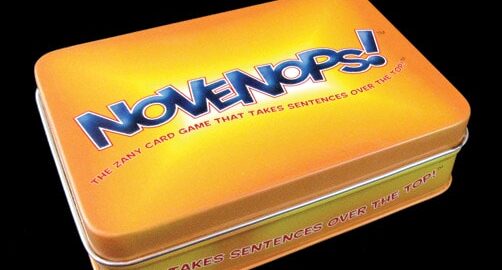When budgets are tight and space is limited it is essential that the tools in your therapy toolbelt are multitaskers! Games are a fun and engaging therapy tool that can be quickly set up to address many therapeutic AND educational goals. In this post we are going to take a look at all the ways the game NOVENOPS can be adapted to meet a variety of therapeutic goals.
What is NOVENOPS ?
NOVENOPS is a popular game that is easily adaptable to all ages and levels. Best of all Kids LOVE it! NOVENOPS is a card game designed to develop an understanding of the basic elements of grammar and sentence structure. NOVENOPS is an acronym created from the words NOun, VErb, NOun, and Phrase. It includes 52 cards, a heavy duty foldable game board and directions all in a portable tin box.
Basic Rules for Playing NOVENOPS!
- Goal – be the first player to discard all of the cards from their hand
- Time- about 15 minutes
- To Play: Unfold the enclosed “game board” and place it within reach of all players.
- After shuffling the game cards, deal 5 cards to each player and place the rest of the cards in the center of the board
- The first player plays a noun card from their hand onto the Noun space on game board; if they do not have a Noun card, then they draw from the deck.
- The next play is a Verb card, followed by a Noun card and finally a Phrase card.
- Repeat until one player has played all the cards in their hand. They are the “winner.”
For more information, check out the video below.
Modifying Game Play to Target Different Goals!
The Reluctant Writer With Handwriting Goals
Modifying NOVENOPS to meet handwriting goals can be done simply by adding a scoring element. Game play follows the basic rules of NOVENOPS with the following modifications:
- Players all receive a ‘scoreboard’ at the start of game play. This scoreboard can be any writing paper that is appropriate for the player.
- Playing a ‘Phrase’ card ends the round and whoever played that card is the winner of the round.
- The winner of the round writes the sentence they created on their scoreboard as a means to keep score and then play moves to the next round.
- Whoever has the most silly sentences written on their scoreboard at the end of game play, wins!
The Reluctant Conversationalist With Expressive And/ Or Receptive Language Goals
Targeting expressive and/ or receptive language goals while playing NOVNOPS typically doesn’t involve changing game play rather changing the pace of the game. Try this:
- Set up NOVENOPS as described above and follow the basic instructions for game play.
- After each round (when a phrase card has been played) take a moment to pause and reflect on what is happening in the sentence. For example, players have created the silly sentence “The mother hid the dinosaur in the refrigerator”.
- Target those language goals! These targets can be simple and concrete ‘wh’ questions like; “Who hid the dinosaur?”, “Where is the dinosaur”, “What happened?”, “How did the dinosaur get in the refrigerator”. Or they can involve more creative thinking; “Why do you think the mother hid the dinosaur in the refrigerator?”, “What do you think the dinosaur will eat while he is in the refrigerator?”.
The Squirmer With Academic Based Goals
Adding a movement component to seated tasks can do wonders for focus and attention. One of the easiest ways to make NOVENOPS a movement game is to turn it into a type of obstacle course. Here’s how to do it:
- Set up a course with three pathways
- At the end of each pathway stack three piles of NOVENOPS cards (a stack of noun cards, a stack of verb cards, and a stack of phrase cards).
- Depending on the student’s abilities, create obstacles or motor challenges along the paths. For example a chair they have to wiggle under, a stack of books they may have to step over, or a winding path they may have to zig zag through.
- Whoever creates the most sentences before time is up wins!
- Pro Tip: This is a great activity idea for therapists doing push in sessions!
A little creativity can go a long way in making the tools in your therapy toolbelt, multitasking superstars!

